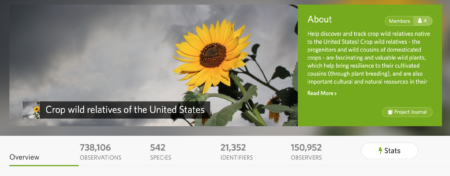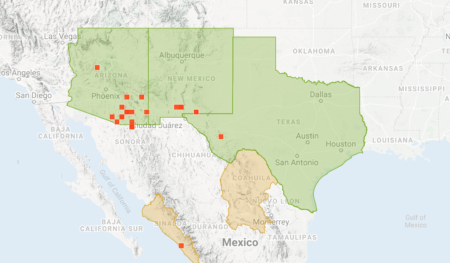- Food contributes 1/3 of greenhouse gas emissions.
- How we got to the above.
- And a focus on how farming started in South Asia in particular.
- A long-term seed experiment carries on.
- Another chapter in the story of the comeback of the American chestnut?
- Want to help a heirloom make a comeback?
- There’s a newsletter on the law and policy behind all this stuff.
Nibbles: Evidence, Agroecology, Iconography, Cryo
- Educational materials for conservation.
- Seminar on agroecology next week by Professor of Agroecology Steve Gliessman.
- Why is there a citron in Van Eyck’s Ghent altarpiece?
- APPS Special Issue Call for Papers: “Meeting the Challenge of Exceptional Plant Conservation: Technologies and Approaches.”
Citizens map crops and their wild relatives
Our friend and occasional contributor Colin Khoury has made a “project” on iNaturalist focusing on the crop wild relatives found in the USA.

iNaturalist collates and manages citizen science observations of living things, with a machine learning algorithm helping with species identification. If the observation you document on your phone app gets verified by two other people, it’s rated as “Research Grade,” and included in GBIF.
Colin also had a go at pulling together observations on major food crops, though there’s no way of including only observations of cultivated material. This is a map of tepary beans (Phaseolus acutifolius), for example.

Cool, no? Join in! There’s only one observation of Bambara groundnut. Surely we can do something about that.
Nibbles: Plant book, Heirlooms, Vavilov, Breeding
- Amazing plant stories from Jon Drori.
- An amazing crop diversity stat from DW.
- Amazing botanist story.
- Kind of amazing this got published.
A taste of coffee to come
Seems like it’s probably worth recapping the whole new-species-will-save-your-morning-coffee-from-climate-change story that’s been going around.
It all started last year with a paper describing the rediscovery in the wilds of Sierra Leone of a species of coffee that used to be very well liked but then fell out of commercial favour due to low yields. It’s called Coffea stenophylla 1 and of course Jeremy did a podcast about it, interviewing one of the authors of said paper, the very engaging Prof. Jeremy Haggar.
Fast forward a year and we now have a follow-up paper assessing the taste of coffee made from beans of C. stenophylla from that (very tiny, alas) wild population in Sierra Leone and also from a (more substantial) CIRAD research stand in La Reunion. And guess what? It’s really good. So of course Jeremy went back to Prof. Haggar for another nice chat.
C. stenophylla grows in hot and humid lowlands, so it’s a little more ready for climate change than your average arabica. 2 Still, the yield issue is presumably still there, and no doubt other problems will arise, as they always do. But I’m keeping my fingers crossed, because I really want to taste the stuff — and boost Sierra Leonean business along the way.
Oh and of course we’ll have to revise the global coffee diversity conservation strategy now…